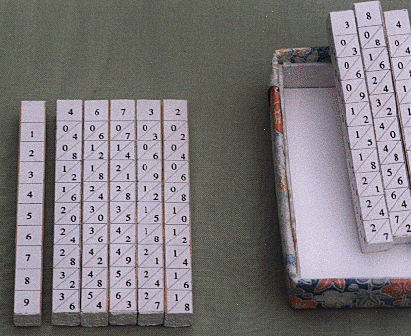








|
Nearing the end of his life, John Napier, who is generally considered the inventor of logarithms, developed an ingenious arithmetic trick - not as remarkable as logs, but very useful all the same. His invention was a method for performing arithmetic operations by the manipulation of rods, called ďbonesĒ because they were often constituted from bones and printed with digits. Napierís rods essentially rendered the complex processes of multiplication and division into the comparatively simple tasks of addition and subtraction.
One version of Napierís rods is displayed in the picture below:

Picture: Private collection of G.W.J. Beckers
As we can see, each rod contains ten squares: the first is inscribed with the number associated with the particular rod; the remaining nine are each bisected by a diagonal running from the lower left to the upper right. Leaving aside the first square, which is each rodís number, the nth square contains the result of multiplying the rod-number by n so that the upper triangle of the square contains the most significant figure and the lower triangle the least significant figure, e.g. in the rod numbered 7, the fifth square, contains the number 35 written in this form.
Now, letís try to multiply 46,732 by 5. The fifth square of rod 2 contains the number 10. So 10 is placed in the units position. The fifth square of rod 3 contains the number 15. So 15 is placed in the tens position. The fifth square of rod 7 contains the number 35. So 35 is placed in the hundreds position. By continuing this process for the remaining rods we get:

The rods were extremely popular in Napierís day and oddly, they constituted the Scottish mathematicianís chief claim to glory among his contemporaries. It is indicative of the poor knowledge of arithmetic at the time, that extensive use was made of Napierís rods all over Europe, since even the simplest arithmetic operations were beyond the reach of most peopleís abilities. Thus, the rods circulated widely in basic, middling and deluxe versions. An expensive edition was also available, in which the rods were made out of ivory and they came in a carrying case of fine leather, with an addition table attached to the lid, which was included for good measure. Later on, the rods were replaced by cylinders (in which case all the rods from 0 to 9 were displayed on each cylinder) and fitted into wooden boxes. Instead of placing the rods on a board equipped with a vertical index labeled from 1 to 9, all you had to do was to rotate them in their places in the box. Napierís invention was employed extensively by people whose work depended on calculations and numbers, such as accountants, bookkeepers etc. The value of Napierís rods is exemplified by the fact that they were still being used in primary schools in Britain in the mid-1960s to assist in teaching multiplication.